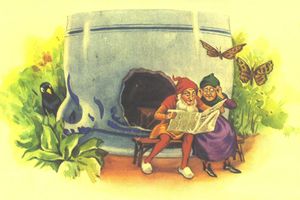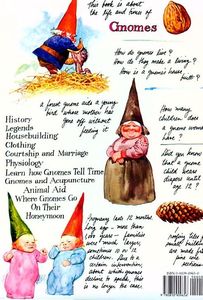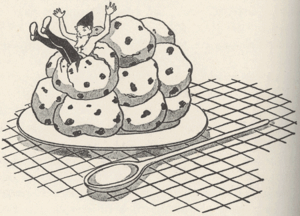Kabouters
Delft, rain and sun together, not too cold
Today I feel like talking about mythology. Dutch mythology. This sounds incredible as Dutch people are very down-to-Earth sort of people, not at all the kind of people to recognize alien spaceships in the oddly formed clouds above their heads. But there exists a whole world of fairies, witches, kings and Thunder-gods, told to the children at bedtime. Dutch children stories are wonderfull.

Piggelmee and his wife Tureluur
One of the most common creatures in this Dutch stories is the kabouter. The word kabouter comes from the middle-age French "gobelin" which gave in English "kobold" and "goblin". But the modern kabouters has nothing to do with the evil medieval spirit it once was. Kabouters became popular as friendly, little beings with red hats. Today they still populate the gardens all over the world. They originally live on and in mushrooms (like the smurfs, just that those are more blue and have white hats...) but lots of kabouters at one point moved in more cosy homes. 
All you ever wanted to know about kabouters has been written and drawn by Dutch painter Rien Poortvliet, whose books are ugely popular, and not only in Holland. His books were even translated into French, and that's saying a lot for such a topic...
According to Rien Poortvliet, kabouters are more familiar to you than you expect: what do you think about the Little Riding Hood story? A little girl with a funny red cap eaten by a wolf? Come on! This was a poor kabouter who was by accident eaten a wolf...
The first kabouter I heard about was Pinkeltje told by my mother as a bed-time story. Pinkeltje lives with mice in a hole in the Big House (Het Grote Huis), and as indicated in the preface of the books tells his stories directly to Mijnheer Dick Laan, who copies them.
Another bed-time stories were the adventures of kabouters Okkie Pepernoot and Piggelmee. The first one lived in a forest, the second in a old pot on a beach. Piggelmee always drank a lot of coffee in his stories, something I always found very dutch... until I discovered that originally the stories were written as a commercial for Van Nelle coffee...
The funny thing is that all these stories works wonderfully well when told in Dutch, but sounds terrible in any other language. I read some translations in English and French and got bored. There is a kind of special music and rhythm in Dutch that is not achieved in an other language.
See for yourself:
Pinkeltje en de oliebol
Pinkeltje zat met zijn gezichtje voor het muizenholletje, achter de etenskast, en keek de kamer in. De deur ging open en de moeder kwam binnen. ‘Hè,’ dacht Pinkeltje, ‘wat ruik ik daar toch voor lekkers en hij snufte wel zeven keer met zijn neusje.
Nu was Pinkeltje erg nieuwsgierig, wàt er zo lekker rook in de keuken en toen dan ook de moeder weer de kamer uitliep naar de keuken, liep Pinkeltje heel zachtjes achter haar aan.
In de keuken zag hij een grote pan met iets er in, dat naar olie rook, en op de tafel stond een kom met meel. Moeder begon in het meel te roeren, en goot er melk en krenten en rozijnen in en ze had een grote houten lepel, die ze telkens even omhoog hield, zodat Pinkeltje het deeg met de krentjes er in zien kon. Toen nam de moeder nog een lepel, schepte er wat deeg uit, maakte er met de twee lepels een bal van en liet die voorzichtig in de pan vallen.
‘Sssst-sssst-ssssst,’ siste de hete olie in de pan en wéér liet de moeder een bal in de pan vallen en weer deed de olie ‘ssst-ssst-ssst’. Toen prikte de moeder met een grote vork in de pan en toen zag Pinkeltje een prachtige, bruine oliebol er uitkomen, en die rook zó lekker!
[...]
[from: De avonturen van Pinkeltje]





/https%3A%2F%2Fstorage.canalblog.com%2F87%2F03%2F341926%2F41606797_o.jpg)
/https%3A%2F%2Fassets.over-blog.com%2Ft%2Fcedistic%2Fcamera.png)
/https%3A%2F%2Fstorage.canalblog.com%2F19%2F67%2F341926%2F27592873_o.jpg)
/https%3A%2F%2Fstorage.canalblog.com%2F42%2F60%2F341926%2F27095876_o.jpg)
/https%3A%2F%2Fstorage.canalblog.com%2F55%2F70%2F341926%2F25656484_o.jpg)
/https%3A%2F%2Fstorage.canalblog.com%2F10%2F02%2F341926%2F24517010_o.jpg)
/https%3A%2F%2Fstorage.canalblog.com%2F44%2F86%2F341926%2F23834887_o.jpg)